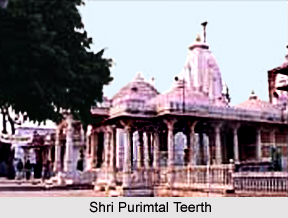 Shri Purimtal Teerth located in Uttar Pradesh is a Jain pilgrimage centre. The teerth kshetra is located is in the Allahabad city. The temple is dedicated to Bhagawan Adishvar. The holy teerth is located on the confluence of the holy rivers of India namely, the Ganga River, the Yamuna River and the Saraswati River.
Shri Purimtal Teerth located in Uttar Pradesh is a Jain pilgrimage centre. The teerth kshetra is located is in the Allahabad city. The temple is dedicated to Bhagawan Adishvar. The holy teerth is located on the confluence of the holy rivers of India namely, the Ganga River, the Yamuna River and the Saraswati River.
History of Shri Purimtal Teerth
According to history Shri Purimtal Teerth dates back to the ancient times. The teerth kshetra dates back to the time of Bhagwan Rishabh Dev. Earlier the teerth kshetra was known as Prayag. The Akshray Vatavruksha` can still be seen here. It is the holy tree under which Lord Adinath attained omniscience. The presence of sandals of the Lord has been mentioned in the Tirthamala of the year 1556 of the Vikram Samvat Era. This is the land of the attainment of omniscience of the first samavasarana of the Lord. It was done by gods headed by Lord Indra and others. This is the land of the attainment of Matamarudeva`s omniscience, of the first religious sermons of Lord and others. The establishment of the fourfold Sangha and the foundation of doctrines of the Jain religion were also done here. It is here that the Gaumukh Yaksa and goddess Pratichakra (Chakreshvari) become Shsandev and Shasanadevi respectively. Purimtal has also been visited by many Jain Tirthankaras. The Ashram of Bhardavaj Muni was also constructed here. According to Mahabharata the Lakshagriha was built here by the architect Maya under the instructions of the Kauravas to kill the Pandavas. The teerth Kshetra is also a sacred place of Hindus.
There is an extraordinary mention of this teerth in the `Vividh Tirth Kalpa` written in the 14th century and many other tirthmalas. This is a sacred place of Hindus, too. The idol of Bhagawan Adishvar is believed to possess miraculous powers. Devotees from far off places visit the temple to offer their prayers. It is believed that if prayed with all devotion the Lord fulfils the wishes of the pilgrims.
Temple of Shri Purimtal Teerth
The temple of Shri Purimtal Teerth houses the idol of Bhagawan Adishvar. The Swetambara temple has been magnificently decorated with intricate artistic designs. The creative temple work boast about the skills of the craftsmen. The idol of the lord is almost 60 cm in height and is white in colour. It is seated in a padmasana posture. The idol has been beautifully carved from a single stone and looks very appealing. The smiling face of the Lord looks very calm and serene. Apart from this there is a Panchavati temple of Digambaras located in this compound. A museum has also been set up here in the vicinity of the temple by the municipality. The museum proves to be very informative and houses a spectacular collection of many ancient Jain works of art and idols. An ancient pillar in this fort is also seen here that adorns the beauty of the temple. It was built by King Samprati. The pillar has many inscriptions inscribed on it. It relates the glory of the king and his rule and career. Other than these there are twelve Swetambara Jain temples.
The Temple of Shri Purimtal Teerth organises many annual gatherings and functions. The Kumbamela is held here once every twelve years. Lakhs of devotees bathe here in the confluence of the rivers and obtain the blessings of the Lord. There are provisions for dharamshalas or rest houses for the pilgrims. These are well equipped with all modern facilities. Apart from this there are Upashrays, an Ayambilshala and a Jnanabhandar. The temple being located on the confluence of the three holy rivers is enclosed by scenic beauty that enthrals and fascinates the pilgrims. The calm and tranquil environment and the surrounding greenery make it a suitable place for religious activities. The kshetra is well connected to road, rail and air. Taxi services and bus services are easily available here. The nearest bus stand is located at Varanasi. The nearest railway station is located at Allahabad which is at a distance of 4 kilometers. The closest airport is also situated at Allahabad.




















